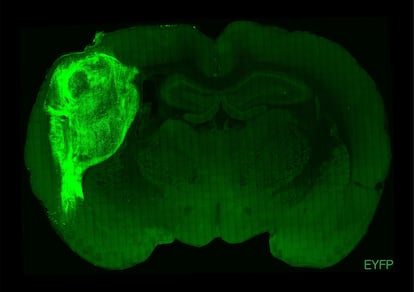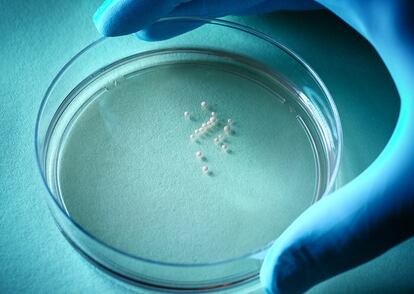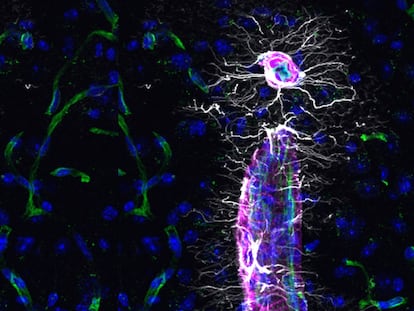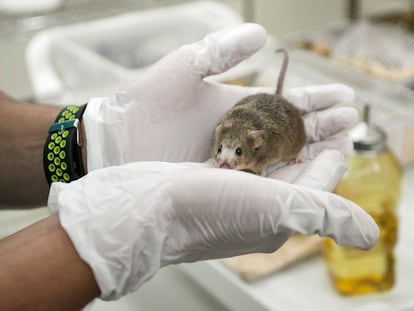Scientists transplant human neurons into rats and modify their behavior
The breakthrough could revolutionize our grasp of psychiatric and neurodegenerative diseases, but it also raises delicate moral questions

A team of scientists at Stanford University has transplanted human neurons into the brains of newborn rats and ucceeded in getting the implanted brain tissue to thrive and influence the animals’ behavior. The breakthrough opens a new window onto the study of psychiatric diseases, but raises thorny bioethical questions concerning the moral status of rats carrying human neurons.
The team headed by Romanian scientist Sergiu Pasca, 40, specializes in producing neural organoids: tiny brain-like structures a few millimeters in diameter grown from human stem cells, which are used in the laboratory to study the functioning of the real and much more complex organ. A human brain weighs one and a half kilograms and has about 86 billion neurons compared to the organoid’s several million.

Pasca’s team takes cells from a human’s skin and subjects them to a chemical cocktail to reproduce their embryonic state, a stage at which they are capable of becoming any organ in the body: liver, muscle, kidney or brain. In this case, the scientists guided the cells to mimic the brain. But, in general, an organoid can only mimic a human organ to a certain extent. As they don’t develop blood vessels, they cannot receive nutrients and don’t survive for long.
Pasca explains, however, that his team was able to ensure the growth and full integration of the human stem cells in the rats by injecting them into the somatosensory cortex. In a human, the growth of a baby’s neurons depends on sensory stimulation. The somatosensory cortex receives signals from the rats’ whiskers and other sensory organs and passes them along to other brain regions to interpret. Hence, the transplanted brain organoids were able to grow, mature and feed through the rats’ blood vessels and, having been successfully integrated, the transplanted neurons can send signals and respond to environmental cues picked up by the whiskers.
But Pasca does not believe that his animals have developed anything resembling a human consciousness, given the type of cells involved and their imperfect integration. “To understand psychiatric disorders, we need better models. And, the more human these models are, the more we will have to address the ethical issues,” says Pasca, who advises against using the technique on monkeys or apes. “We need to strike a balance between the potential benefits of avoiding some of the suffering caused by devastating brain disorders and the risks of generating models that are too similar to humans.”
The team’s study has been published in the journal Nature, with authors including the American neuroscientist Karl Deisseroth, father of optogenetics, a revolutionary laser technique that makes it possible to activate or deactivate neurons, thanks to the prior introduction of genes from light-sensitive algae. Researchers have used this tool on rats trained to lick a tube if they want water. When their human neurons are activated by light, the rodents come to lick the device, so the scientists can deduce that their transplanted cerebral cortex is involved in the learning processes.

Pasca believes that the main application of the results of the experiment will be in the realm of disease research. His team has already started with the Timothy syndrome, an extremely rare disorder that causes severe neurological and cardiac problems in children, with symptoms similar to those of autism and epilepsy. The scientists have transplanted cells from three patients into rat brains and detected previously unknown neural defects. The Stanford lab is also investigating two dozen other brain disorders, including autism and schizophrenia. “We can now test new drugs on animals and study their effects on transplanted human neurons,” explains Pasca.
Neuroscientist Raül Andero, from Barcelona’s Autonomous University, has pioneered the study of memory in mice using optogenetics. Andero calls the new study “spectacular,” adding that “it opens up a whole new field. I’m completely blown away. It has absolutely incredible implications for research into neuropsychiatric and neurodegenerative diseases. I don’t even think the authors have had time to think of all the applications. We are going to spend years discovering them.”
Regarding the ethical concerns, Andero believes that it is important not to cross any red lines. “We have to be very careful,” he says. “In neuroscience, it’s almost the same as in the driverless car sector, where the debates end up being more ethical than technological.”
Pioneering work by Spanish biochemist Ira Espuny-Camacho 10 years ago at the Université Libre de Bruxelles already showed that human neurons can be integrated into the brain circuits of a mouse. The Stanford team has now taken neuroscience into uncharted territory and the ever-shifting frontiers of bioethics by demonstrating that these foreign neurons can actually impact a rodent’s behavior.
Tu suscripción se está usando en otro dispositivo
¿Quieres añadir otro usuario a tu suscripción?
Si continúas leyendo en este dispositivo, no se podrá leer en el otro.
FlechaTu suscripción se está usando en otro dispositivo y solo puedes acceder a EL PAÍS desde un dispositivo a la vez.
Si quieres compartir tu cuenta, cambia tu suscripción a la modalidad Premium, así podrás añadir otro usuario. Cada uno accederá con su propia cuenta de email, lo que os permitirá personalizar vuestra experiencia en EL PAÍS.
¿Tienes una suscripción de empresa? Accede aquí para contratar más cuentas.
En el caso de no saber quién está usando tu cuenta, te recomendamos cambiar tu contraseña aquí.
Si decides continuar compartiendo tu cuenta, este mensaje se mostrará en tu dispositivo y en el de la otra persona que está usando tu cuenta de forma indefinida, afectando a tu experiencia de lectura. Puedes consultar aquí los términos y condiciones de la suscripción digital.
More information
Últimas noticias
All the effects of gentrification in one corner of Mexico’s Colonia Roma
Palestinian reporter Youmna El Sayed: ‘My family told me I had to choose between being a journalist or a mother’
Russell Tovey: ‘I was advised many times not to come out, I don’t think there was many people who’d done that — and I feel really proud that I’m one of those that did’
Merz tries to replace Macron at the helm of Europe
Most viewed
- The low-cost creative revolution: How technology is making art accessible to everyone
- Families demand repatriation of bodies of Colombians who died in Ukraine: ‘This war is a slaughterhouse for foreigners’
- Christian Louboutin: ‘Young people don’t want to be like their parents. And if their parents wear sneakers, they’re going to look for something else’
- US sanctions against jailed cartel leader ‘El Marro’ highlight Mexico’s lack of control over its prisons
- Liset Menéndez de la Prida, neuroscientist: ‘It’s not normal to constantly seek pleasure; it’s important to be bored, to be calm’











































